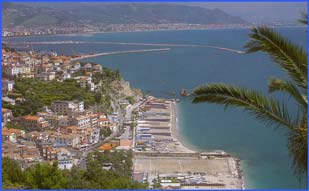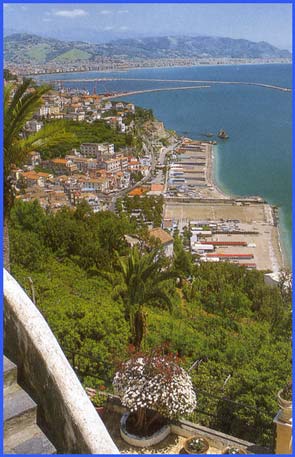








 |
 Close
by Salerno, eastern door of the Divine Coast, Vietri sul Mare has had a tragic
history, full of invasione and ravages. The original settlement, named
Marcina, was destroyed in 455 a.C. by Vandal barbaric hordes or, according to
another versioni by violent civil riots. It was attacked again and sacked
many times by the Longobards in the following centuries, then it was restored by
descendants of the survivors of the slaughters. The new town was
significantly called Vetere (ancient), to underline the historical continuitā
of the different communitics. Close
by Salerno, eastern door of the Divine Coast, Vietri sul Mare has had a tragic
history, full of invasione and ravages. The original settlement, named
Marcina, was destroyed in 455 a.C. by Vandal barbaric hordes or, according to
another versioni by violent civil riots. It was attacked again and sacked
many times by the Longobards in the following centuries, then it was restored by
descendants of the survivors of the slaughters. The new town was
significantly called Vetere (ancient), to underline the historical continuitā
of the different communitics.
Unfortunately,
in the 17th century a French fleet headed by a prince of Savoia attacked again
and despoiled the town.
 Despite
so much mourning, the inhabitants of Vietri have managed to keep the pride of
their own individualitā alive, so that today, even if they are so near a much
larger city, Salerno, they still proudly claim their own identity. For
ever Vietri has been the destination of tourists from near (inhabitants of
Salerno have chosen its beach called "della Crestarella" as their own
bathing salon) and from far (the country gave hospitality to many German artists
during the years between the two world wars). Today Vietri is particularly
famous for its artistic ceramic produetion to which the above-mentioned forcign
artists (Richard Doelker, Irene Kowaliska and others), well-supported by famous
ceramists like Guido Gambone, gave a substantial boost. Despite
so much mourning, the inhabitants of Vietri have managed to keep the pride of
their own individualitā alive, so that today, even if they are so near a much
larger city, Salerno, they still proudly claim their own identity. For
ever Vietri has been the destination of tourists from near (inhabitants of
Salerno have chosen its beach called "della Crestarella" as their own
bathing salon) and from far (the country gave hospitality to many German artists
during the years between the two world wars). Today Vietri is particularly
famous for its artistic ceramic produetion to which the above-mentioned forcign
artists (Richard Doelker, Irene Kowaliska and others), well-supported by famous
ceramists like Guido Gambone, gave a substantial boost.
Vietri
has various churches of remarkable architectonic interest: above all we point
out the majolica dome of the Church of S. Giovanni and its octagonal tower;
however, the real beauty of the town is represented by the common houses; all,
more or less, are enriched by splendid majolica pieces, often made by famous
artists. A walk in the town also allows you to visit the numerous
beautiful shops of the ceramic artisans.
|
